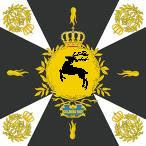I’ve been browsing back through an old stack of wargames magazines from way, way back in the early 1990’s which I recently found in the loft, looking for some inspiration for a future campaign. Reading through them, I was reminded of a system which was mentioned in one or two articles – I was always intrigued by them, but never actually got round to trying them. I’m pondering perhaps using them in my next campaign. For the sake of giving ‘food for thought’ I decided I’d detail them here and see if anybody had any comments – perhaps they’ve been used by someone who can advise on them, or if not they might perhaps inspire somebody.
The game uses a simple ‘area map’ and the movement of armies on it is determined by a deck of cards. The one below uses 54 in total, made up as follows (I’m sure you could tailor the cards easily to make them more ‘period suitable’ and perhaps cut the deck size)
Normal March(x4)
Forced March(x2)
Rest/Prepare(x2)
Rally(x2)
Ambush(x2)
Skirmish(x2)
Open battle(x4)
Tactical advantage(x2)
Large formation(x2)
Small formation(x2)
Motivation(x2)
Fatigued(x2)
Victory/Defeat(x2)
Rout(x2)
Halt(x2)
Retreat(x2)
Morale increase/drop(x2)
Recruit/desert(x2)
Weather Effect(x1)
Terrain effect(x2)
Supply lines(x2)
Battle Cry(x1)
Love(x1)
Anger(x1)
Fear(x1)
Shame(x1)
Wild Card(x4)
Basically you just get dealt about 5-20 cards a turn (in multiples of five, depending on how good your general is) and then play them each turn to decide what you do. You need to propose an action, a result, and give three reasons why. For Example:
Luftberg gets ten cards and decides it will:
Action: make a FORCED MARCH into an adjacent province containing an enemy force.
Result: it will then AMBUSH the enemy, catching him by surprise. This will succeed because…
Reason 1: the enemy will have a MORALE DROP when caught unexpectedly,
Reason 2: Some rough terrain on the border will have a TERRAIN EFFECT and conceal the Luftberg approach,
Reason 3: the troops will be eager to attack as they feel ANGER against the enemy who have invaded their home province.
The proposal is weighed up for plausibility, and then a dice is rolled to decide if it succeeds. A plan with poor reasons should only succeed on a long-shot roll of 6, while an undemanding and straightforward scheme could succeed on a 2+ (it’s a good idea to make a 1 always a failure, however good the plan, to keep an element of chance.) If it succeeds it gives a good basis for a tabletop combat scenario, such as the above example which could be done with combat modifiers, concealed deployment by the attackers, etc. etc.
The rules initially put me off as they needed an umpire to judge the proposals, but it seems like a good advantage for something like this solo blog project, where the narrative is as important as the actual campaign and characters. It also seems good for 18th Century stuff, where you tend to have only a few big armies on the move, and the cards can easily be tailored to suit particular features.
Subscribe to:
Post Comments (Atom)


4 comments:
I'm in the very early stages of setting up an 18th century solo campaign and this does sound interesting. I've already a map divided into provinces so these cards might fit in nicely. Not sure what the wild cards would be and a 'battle cry' doesnt sound too 18th century to me!
Are you saying that just one side uses these, the resulting battle is played out, then the other side plays their cards?
I could see a decent general being given say 12 cards, an average one 8 and a poor one 5...
You could also post proposals on your blog and ask for comments.
Hi Andrew - good luck in your own upcoming blog. I'll be sure to keep an eye out! I agree that the 'battle cry' is the most anachronistic and needs replacing ('inspiring commander' perhaps, to get a few more characters into the picture?) Also, I'm tempted to just skip the wildcards.
Fitz-badger - you read my mind! I'll outline the idea I've been toying with in my next post, to see how it turns out.
Cheers,
C
P.S. - sorry Andrew, I just realised I hadn't answered your questions!
The plan is for each player to draw cards of the deck (I'm thinking about 10 at a time) and then each proposes a move in turn. After both have gone, the cards are all reshuffled and each side draws another hand of 10 cards. The whole thing gets repeated until one side is too battered to continue and concedes.
Post a Comment